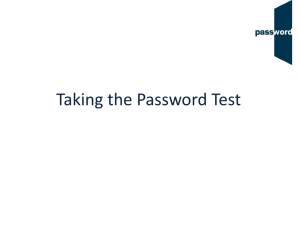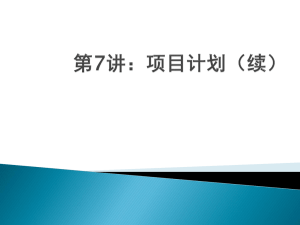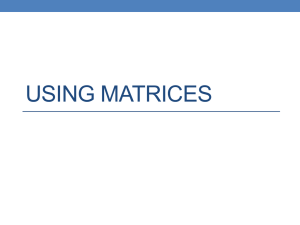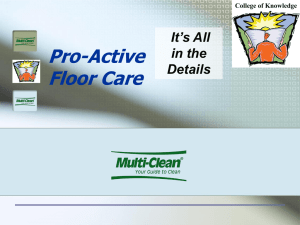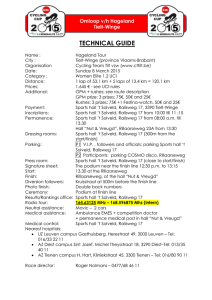HP Resilient Floor Care
advertisement
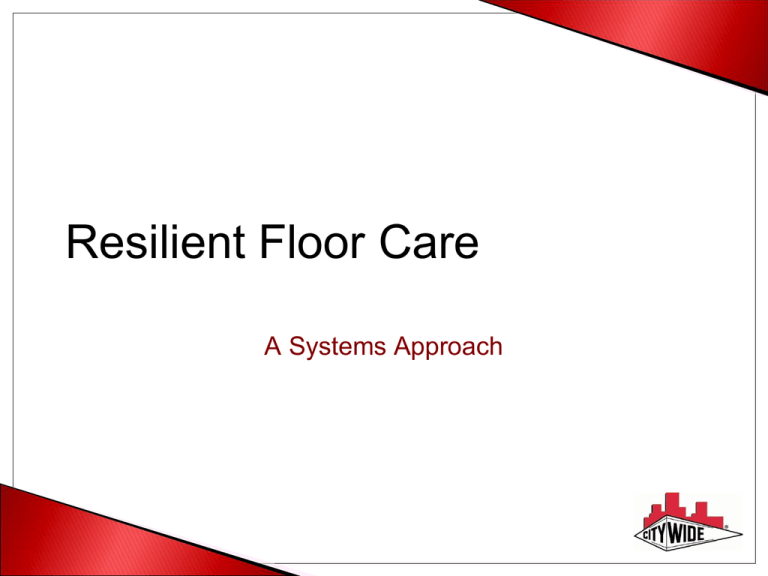
Resilient Floor Care A Systems Approach What Is Resilient Flooring? • Definition of Resilient: Bouncing or springing back into shape, position, etc. after being stretched, bent or, especially, compressed. • • • • • • Vinyl Composition Tile (VCT) Linoleum Sheet Vinyl Rubber Cork Synthetic Sports Floors Non-Resilient – Resilient Flooring • Radial rubber & Cork flooring – Too resilient. So much flex, acrylic finishes tend to shatter – Need to use a true carnauba wax system • Synthetic (non-wood) sports flooring – Need to use a finish system that allows for more traction and durability than regular floor finishes Selecting A Cost-Effective Finish System • Use a seal? • Use a finish? • Use a seal/finish? – How many coats? – How often? • Burnish? – Do we have a machine? – What speed? – Which pad? • Use a restorer? – Spray on? – Mop on? – How often? • How does it wear? • How high gloss? – How often is there time for: burnishing? Refinishing? • Using a restorer? Trilogy® Floor Care System • Ultra high speed burnishing – Over 1500 rpm • Cord-electric to 2000 rpm • Battery and propane to 3000 rpm • High speed burnishing – 500 - 1500 rpm • Standard speed – 125 - 500 rpm • Products to match your equipment • Choose the program that fits your facility Systems & Programs • Systems generally refer to “sets” of products designed to work together • Programs generally refer to cleaning programs – All cleaning programs have three steps: • Daily maintenance – dust mopping & damp mopping • Interim maintenance – burnishing; scrub & recoat • Renovation - stripping – The better the daily maintenance is performed the longer the interval between interim procedures – The better the daily and interim maintenance is performed, the longer between renovations Hillyard’s Philosophy • Cost effective programs revolve around using time-efficient procedures, not cheap products – Labor makes up 85-90% of M&O budget • Saving 10% on products saves 1% of budget • Saving 10% on labor saves 8 ½ -9% of budget – Begin all cleaning programs with renovation – “start clean to stay clean” – Perform daily maintenance tasks in such a way as to minimize interim procedures – Perform interim procedures in such a way as to minimize renovative procedures • Renovative procedures use the most labor • So, the resilient floor program begins with… Stripping The Floor • Is stripping always necessary? – NO! – Only when: • Changing coating systems • Changing suppliers • Removing heavy buildup • Removing factory coatings on new floors Stripping The Floor • • • • • • Apply stripper Let stand recommended time Agitate edges & hard to reach areas w/ swivel pad holder Scrub with single disc floor machine (buffer) Use a wet-vac to pick up solution Neutralize the floor (stripper) – The stripper that removed finish will inhibit the new finish bonding to the floor • • Rinse at least twice with clear water Check the floor for residue Stripping Don’ts • Stripping is a process, not an event – Everyone must work together • Don’t drag cords through solution and onto the clean floor • Don’t roll wheels through stripping solution and onto the clean floor Stripping Don’ts • Don’t walk through stripping solution and onto the clean floor • Don’t allow stripping solution to dry back on the floor, or on baseboards, doors, walls, cabinets, etc. • Don’t allow stripper or neutralizer to dwell on the floor too long – this can damage the tile Stripping Don’ts • Don’t allow stripping solution to run under doors or to splash onto an area that will not be stripped • Don’t splash stripping solution onto adjacent carpeting • Don’t use an auto-scrubber to apply stripping solution – it will destroy pump seals Stripping Don’ts • Don’t use an auto-scrubber to pick-up stripping solution – and if you do… • Don’t store equipment (including mop buckets and wringers) without cleaning – Clean using clean stripping solution – Clean the entire machine – squeegees, recovery hoses, recovery tanks, underside of scrub decks Stripping Do’s • Protect areas that won’t be stripped – Make dams under doors or in doorways – Lay towels or tarps on adjacent carpeting – Roll equipment over towels before transporting out of the area to protect adjacent flooring – Wipe your feet before walking onto adjacent flooring • Pay attention to details – Badly stripped edges and corners make the whole floor look bad Stripping Do’s • Coat vertical surfaces (baseboards, cabinet fronts, doors etc.) with Super Hil-Tone before stripping – – – – Will help shed the stripping solution Inhibits finish dry-back Minimizes clean-up with stripping solution Remember to clean the treated surfaces later Rinsing the Floor • After neutralizing, give the floor two additional clear water rinses • Don’t forget the baseboards and corners! – Cove base cement may dissolve & ooze back on to the floor - it will look like yellowed finish! • When the floor is dry, wipe your hand over the surface. If it comes up with a residue, give it another rinse. If there is no residue, the floor is ready for sealing. Sealing The Floor • Apply same as finish – Clean, damp synthetic finish mop, flat finish mop, or finish applicator (not dripping) – Cut in perimeter first – leave an exit by the door – Apply in continuous passes all the way across the floor • Apply every other coat in the opposite direction Why Seal? • Seal protects the flooring • Seals are “generally” less expensive than finishes (depends on the finish) – Seal has larger molecules, so less “soaks into” the floor – Seal provides a base for finish – You use less finish • Follow recommended coverage rates • Think of plywood – several thin coats makes a very strong, durable product Finishing The Floor • Apply floor finish in the same way you applied the seal • Allow adequate drying time between coats – If too many coats applied too quickly or too thickly • Delamination can occur • Plasticizer migration can occur • Will cure softer, and be less durable Floor Finish • 99.9% of today’s floor finishes contain no wax – Today, we finish floors, we don’t wax them. • How many coats? – Rule of thumb: divide the % solids of the finish into 100. The answer is the number of coats to get optimum appearance. • How thick? – Rule of thumb: thinner is better. Use middle of mfg.’s recommended application rate • If 1000 – 1500 sq. ft./gal. per coat, aim for 1250 sq. Ft. Applying Finish • Stay away from the baseboards Applying Seals & Finishes • Buffers can’t scrub the last 2 in. of the floor to the edge. – Over time, finish can build up – unless the edges are hand scraped every time the floor is scrubbed, a time-consuming and labor-intensive process. Applying Seals & Finishes • Apply the first coat as close as possible without touching the baseboard • Apply each successive coat two inches inside the previous coat will feather the finish to the edge, preventing buildup and requiring less hand-work when scrubbing or stripping. – People don’t walk right next to the wall, and in rooms there is usually furniture against the walls. – In halls and large open areas with no furniture, the first coat touching the baseboard without slopping up on it to prevent a “dry” gap is acceptable. Gloss Restoration • Mop-on restorers – Mop on after cleaning (mopping or auto-scrubbing) the floor, let dry then burnish • Mop-on cleaner/restorers – Use in an auto-scrubber to clean and apply restorer in one step before burnishing – No auto-scrubber? • Use to mop the floor clean and apply restorer in one step before burnishing Gloss Restoration • Spray buffing – regular speed – On a clean floor, apply a mist of spray-on restorer to a small area (5’x5’) – Immediately, with a standard 175 rpm floor machine with a white pad, go over the sprayed area, back and forth until it dries and polishes • Useful for blending out traffic lanes • For general gloss restoration • Turn and change pads frequently • Dust mop when finished • Time consuming – not the process of first choice – If you only have a 175 rpm machine Gloss Restoration • Spray buffing – high & ultra-high speed – On a clean floor, apply a mist of spray-on restorer to a small area (5’x5’) – Immediately, with a burnisher with a beige polythermal pad, go over the sprayed area, until it dries and polishes. • For general gloss restoration • Turn and change pads frequently • Dust mop when finished • Time consuming – not the process of first choice Gloss Restoration • Dry burnishing – high and ultra-high speed only – Use beige polythermal pad – Most effective with “softer” finishes • General rule of thumb – the higher the solids content, the “harder” the finish • Generally speaking, “harder” finishes do not respond to dry burnishing as well as “softer” finishes • Generally speaking, “softer” finishes don’t powder as much as “harder finishes – Dust mop when finished Daily Maintenance • Dust mopping with a treated dust mop – Removes grit • Grit is as damaging as sandpaper shoe soles – Damages finish – Damages tile – Removes and controls dust • Dust hides the shine • Minimizes hand dusting • Decreases A/C filter changes (indoor air quality) • First line of defense against finish wear Daily Maintenance • Regular damp mopping – Gets what the dust mop leaves • Rinse mop often • Change water often • Auto-scrubbing – – Faster – more efficient • Decreases labor costs • Increases productivity Produces better results – cleaner floors • Reduces drying time Interim Maintenance • “Scrub and re-coat” uses a neutral cleaner – Buffer or auto-scrubber • Red, blue or black pad – Quickly remove only top layer of dirty finish – Pick up solution with a wet-vac – Rinse until clean (wipe hand on floor) – Let dry – Reapply finish • 2 to 4 coats - no more – only replace what you remove Scrubbing vs. Stripping • ISSA standard times per task – Stripping a floor • 75 minutes / 1000 sq.ft. – Scrubbing a floor • 45 minutes / 1000 sq. ft. • Stripping means resealing and refinishing – 3 seal + 3 finish = six coats applying & drying time • Scrubbing means replacing only the finish you scrubbed off – 2 or 3 coats applying & drying time Scrubbing vs. Stripping • Scrubbing floors saves – Time – Money (labor is 85-90% of M&O budget) – Product • Less seal • Less finish • Less neutralizer Controlling Buildup • Many facilities are on a five year stripping rotation (or longer) – They strip only 20% (or less) of floors annually • To prevent buildup when scrubbing, replace only what is removed – Start with 3 seal, 3 finish coats after stripping – Assume one coat wears off and one is scrubbed off – reapply only two coats • If 3 are reapplied the floor will have 4 coats. The next time one wears off and one is scrubbed off and you add three you’ll have 5 and so on. Over a period of time you’ll create a heavy buildup. Review • Start clean to stay clean. • Focus on prevention through diligence in daily maintenance procedures. • Use interim procedures regularly to prevent floors from getting out of control. • Use renovative procedures only as necessary. Resilient Floor Care Are there any Questions? Quiz 1. 2. 3. 4. 5. (T/F) neutralizing after stripping isn’t really necessary. Stripping is necessary when changing , or , when finishing , and if there’s a (T/F) Apply finish the same way you mop a floor. Seal is used to create a for finish. The final step before applying the first seal coat is to floor for . . the Quiz 6. The most important part of a resilient floor care program is . 7. (T/F) The more finish coats applied, the longer you can go between stripping or scrubbing. 8. (T/F) After scrubbing a floor, apply one more coat of Finish than you removed for the best appearance. 9. (T/F) Damp mopping with a cleaner/ restorer is an efficient way to clean and apply a restorer in one step. 10. (T/F) Dust mopping is the first line of defense against finish wear. Answers 1. (F) neutralizing after stripping isn’t really necessary. 2. Stripping is necessary when changing coating systems, or suppliers , when finishing new floors, and if there’s a heavy buildup . 3. (F) Apply finish the same way you mop a floor. 4. Seal is used to create a base for finish. 5. The final step before applying the first seal coat is to check the floor for residue . Answers 6. The most important part of a resilient floor care program is each step is equally important – a floor care program means skipping any step will affect the total performance of the coating system . 7. (F) The more finish coats applied, the longer you can go between stripping or scrubbing. 8. (F) After scrubbing a floor, apply one more coat of finish than you removed for the best appearance. 9. (T) Damp mopping with a cleaner/ restorer is an efficient way to clean and apply a restorer in one step. 10. (T) Dust mopping is the first line of defense against finish wear. Resilient Floor Care Thank you for your participation.


